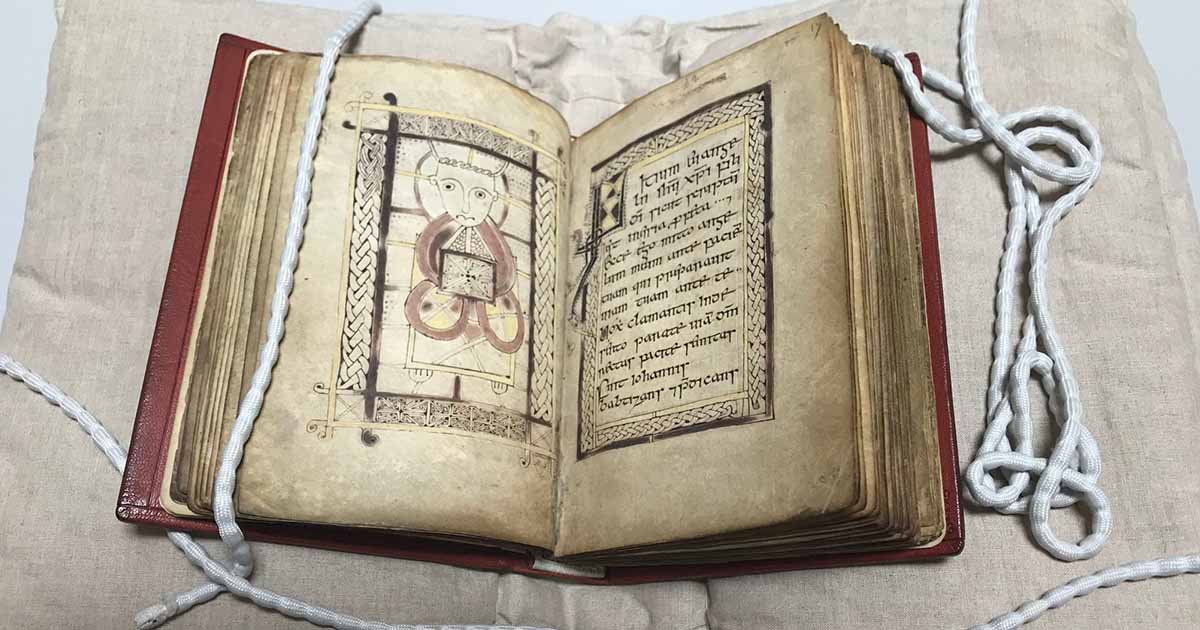Lost Monastery Tied to Oldest Scottish Text “Book of Deer” Unearthed
A monastery, where the earliest surviving Scots Gaelic text was once noted within the margins of a significant Scottish manuscript called the Book of Deer, disappeared from the pages of history about 1,000 years ago. After over a decade of excavations looking for its whereabouts, archaeologists have now confirmed the discovery of the site where the 10th century annotations were written.
The “Extremely Exciting” Remains of the “Book of Deer” Monastery
The anticipation has been building up since 2018 when The Scotsman announced that an excavation team working with the Book of Deer Project had unearthed a hearth, charcoal, pottery, post holes and a layer of stone near Old Deer in Aberdeenshire, Scotland. At the time, experts used carbon dating to conclude that the site was in use between 1147 and 1260, during the medieval monastic period. Meanwhile, the stone and post holes suggested a circular building was once located at the site.
- The Ancient Book of Deer, Oldest Known Gaelic Text in Existence
- 9 Mysterious Undeciphered Codes and Inscriptions in History
“A medieval date for this hand-made pottery suggests the building underneath the layers where the pottery had been found might also be medieval in date,” explained Alison Cameron of Cameron Archaeology, the archaeologist who led the dig, when interviewed by the BBC. “The date for the charcoal is 1147 to 1260 and is extremely exciting because it is potentially the monastic period, so it is dating to the early medieval period when we know the monastery was in the area.”
So they knew the dating was correct, but more investigations were needed to confirm there was a monastery building at the location.
In 2022, Ali Cameron from Cameron Archaeology Ltd and her team conducted extensive follow up excavations, enduring weeks of removing later material to reach the earliest layers of an archaeological site, reports the BBC in this latest update.
Ali Cameron recently explained to the BBC:
"A lot of the rest of the field had been disturbed but we opened such large trenches in 2022 so that we had the best chance of finding early medieval features.
We spent weeks excavating later material including stone and other demolition material until we got down to the earliest layers and features two weeks before the end of the dig.
"I then led a team of students and volunteers and we systematically cut sections though all the features, collected finds and samples which are important as they are where the charcoal for dating will be."
This dig finally revealed the monastery features they had been seeking.
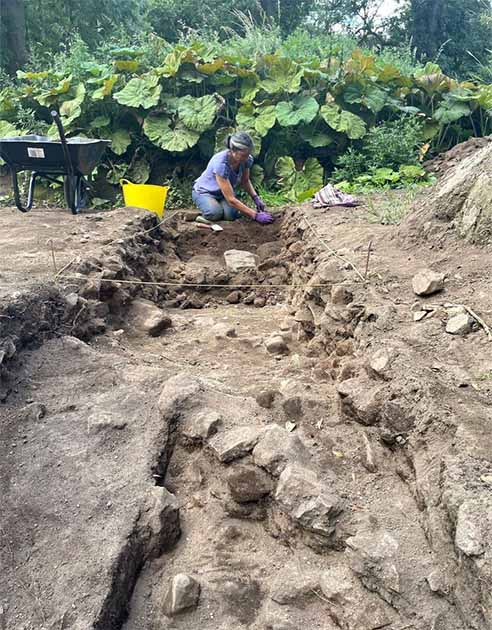
A meticulous excavation was performed in order to reach the lower levels of interest. (Book of Deer Monastery Dig)
The newly collected samples were analyzed at the University of Aberdeen under Dr. Gordon Noble's supervision, and the charcoal was sent to the Scottish Universities Environmental Research Centre (SUERC) in East Kilbride for further processing, to confirm the date of the newly excavated features.
Alice Jaspars, an archaeologist and PhD student involved in the dig sent Cameron the results, saying, “I think you should check the dates”.
Upon receiving the dating results via email, Cameron expressed her astonishment:
"It's just unbelievable. We found the monastery."
The Small But Important Book of Deer
The ancient manuscript, which has been owned by the Cambridge University Library since the early 18th century, takes its name from a monastery which once existed in Deer, in eastern Scotland. Nevertheless, experts have long believed that it was located near the now-ruined Deer Abbey which was built in 1219.
It appears they were right. Archaeologists have now announced that the exact site where Gaelic notes found within the ancient Book of Deer were written. It was just 80 meters (262 ft) from Deer Abbey, located near the village of Mintlaw in Aberdeenshire.
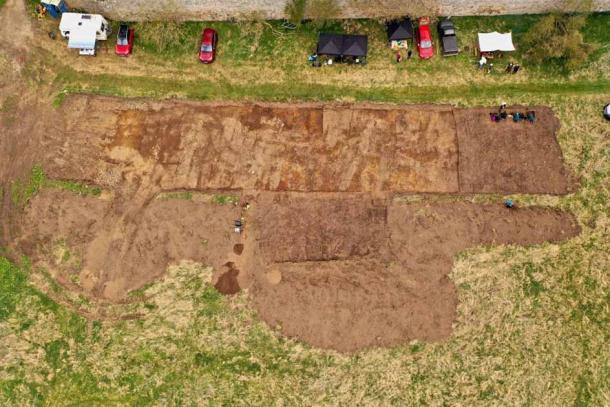
The new dig site has allowed archaeologists to finally locate the monastery where notes within the Book of Deer were written. (Midas Media / University of Southampton)
Finding the Monastery Mentioned Within the Ancient “Book of Deer”
BBC News reported that the initial excavations were aimed at exploring a field near the ruins of Deer Abbey. Focus was placed on that location because a geophysical survey found underground anomalies there.
Before the excavations in the field, archaeologists were looking for the monastery in a church graveyard. “This is a site that we don’t know anything about,” stated Cameron at the time. “The possibility of locating one building and perhaps more nearby would be of national importance. The team are very excited about this.”
Book of Deer: Archaeologists solve oldest manuscript mystery https://t.co/bKXe63J1Tg
— BBC News (UK) (@BBCNews) November 18, 2023
Bruce Mann, an archaeologist for Aberdeenshire Council, expressed his hope for the discovery of the monastery to The Scotsman in 2018. “These latest discoveries may at last hint that the mystery has finally been solved,” stated Mann. “More work obviously has to happen, but regardless of what this finally turns out to be, it is a significant find for not only Old Deer, but Aberdeenshire and beyond too.”
Further clues to the monastery’s location were scribbled in the margins of the Book of Deer in Scots Gaelic. The writings, known as addenda, suggest that the monastery was in eyesight of Deer Abbey – the building the monks moved to when they had to leave their home at the monastery. The National reported that the monks left the monastery before or during the Reformation, when the building may have already been in ruins.

The ruins of Deer Abbey in Scotland, located close to where the monastery was unearthed. (Public domain)
Ancient “Book of Deer” Contains Oldest Known Gaelic Text in Existence
The true interest in the Book of Deer is not actually related to the original manuscript, thought to date back to 1000 AD. It’s actually the addenda, or notes added to the margins, set the text apart. As Ancient Origins previously reported, the Book of Deer:
“is said to be the only pre-Norman manuscript revealing tenth century northeastern Scottish culture’s society and religious traditions, and is the earliest known Gaelic document in existence […] the greatest intrigue for those drawn to this ancient text lies within the handwritten notations made in its margins and other blank areas, and not necessarily within the text itself. The notations, also referred to as ‘notitiae’, are written in the type of Gaelic typically spoken by the upper classes in the early twelfth century region of Buchan […]”
While the contents of the addenda speak of the founding of the monastery of Deer, there are also notes which reference other land grants in the area. There are notes written by at least five different individuals within the margins of the Book of Deer. What has really generated interest is the fact that this is the earliest surviving Scots Gaelic text to have been discovered to date.
Dr. Michelle Macleod, lecturer in Gaelic at Aberdeen University, explained some of the significance of the Book of Deer in an article published in The National. “There are some deviations in the language from the shared common Gaelic of Scotland and Ireland which had been used in earlier manuscripts,” she explained. “These deviations, of which there are several, are the first written indication that the languages are separating and would be an indication of what people were likely saying.”
“The Book of Deer is a tiny book, but it has left a huge legacy for us, not only in the north-east but for the whole of Scotland,” stressed Macleod, when discussing the notes found in the margin within the Book of Deer. “We had to wait another 200 to 300 years after the Book of Deer to find any more evidence of written Scottish Gaelic.”
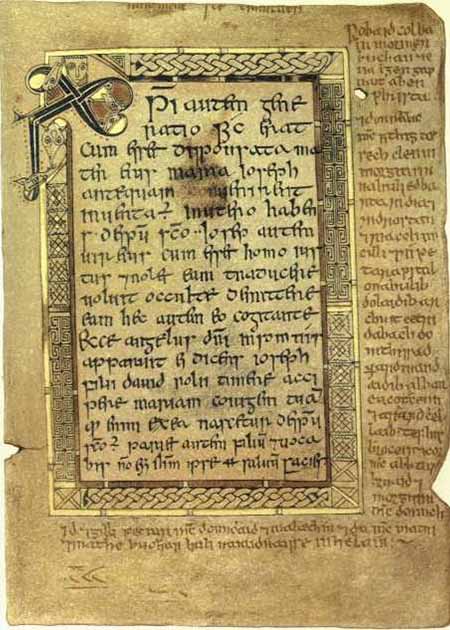
Folio 5r of the Book of Deer which contains the text of the Gospel of Matthew from 1:18 through 1:21. Note the Chi Rho monogram in the upper left corner. The margins contain Gaelic text. (Public domain)
Anne Simpson, chair of the Book of Deer Project, further emphasized the importance of the book, by saying: “The book is as significant as the Book of Kells in Dublin but it is still amazing how even people locally don’t know about it. We have been looking for the monastery for a long time, so there is a great deal of excitement about the discoveries.”
- The Teen Prodigies Behind This 15th Century French Picture Book (Video)
- Medieval Manuscripts Are Full of Knights Fighting Snails
The Book of Deer Project, which started in the 1990s, strives to enhance awareness and understanding of the Book of Deer. Finding the monastery was possible thanks to painstaking excavations which took place in 2022, mainly funded by a National Lottery Heritage Fund grant, during which they dug large trenches in order to find early medieval remains.
Besides pottery fragments and post holes, they even uncovered the remains of hnefatafl boards, an early game reminiscent of chess which was popular up until the Middle Ages. Carbon dating materials uncovered at the site allowed them to conclude that they came from the same time period as the addenda within the Book of Deer.
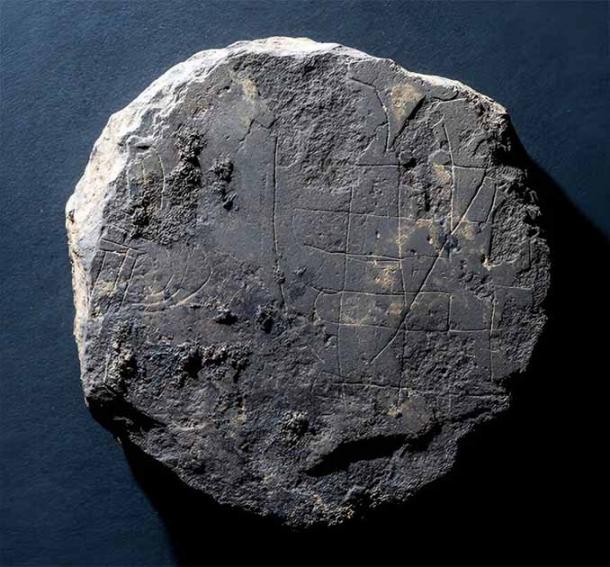
Remains of an ancient hnefatafl board discovered at the newly identified site of the Monastery of Deer, where notes within the Book of Deer are believed to have been written. (Michael Sharpe / University of Southampton)
Top image: The Book of Deer contains notes in the margin which are the first written examples of Scottish Gaelic and hinted at the location of the monastery where they were written. Source: The Book of Deer Project
















